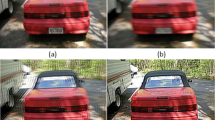Abstract
Conventional non-blind image deblurring algorithms often involve in maximum a posteriori (MAP) estimation and natural image priors. However, MAP estimation has several disadvantages which limit its application. To address these issues, we propose to use Bayesian minimum mean squared error (MMSE) estimation instead of MAP to perform deblurring. The new method is based on high-order non-local range–Markov random field (NLR-MRF) prior, which is an effective statistical framework to model prior knowledge of natural images. The high-order NLR-MRF prior can be integrated into MMSE framework naturally. Then, an efficient Gibbs sampling algorithm is employed to compute MMSE estimation. For convenience of computation, we convert to solve a least-squares problem for sampling latent sharp images. The proposed method frees the users from determining regularization parameter beforehand, which relies on unknown noise level. Both quantitative and qualitative evaluations show superior or comparable results to the state-of-the-art deblurring methods.





Similar content being viewed by others
Explore related subjects
Discover the latest articles, news and stories from top researchers in related subjects.References
Fergus R, Singh B, Hertzmann A, Roweis ST, Freeman WT. Removing camera shake from a single photograph. ACM Trans Graph. 2006;25(3):787–94.
Xu L Jia J. Two-phase kernel estimation for robust motion deblurring. In: European conference on computer vision, 2010.
Yuan L, Sun J, Quan L, Shum H. Image deblurring with blurred/noisy image pairs. ACM Trans Graph. 2007;26(3):1–10.
Rav-Acha A, Peleg S. Two motion-blurred images are better than one. Pattern Recogn Lett. 2007;26:311–7.
Ben-Ezra M, Nayar SK. Motion-based motion deblurring. IEEE Trans Pattern Anal Mach Intell. 2004;26(6):689–98.
Raskar R, Agrawal A, Tumblin J. Coded exposure photography: motion deblurring using fluttered shutter. ACM Trans Graph. 2006;25(3):795–804.
Shan Q, Jia LJ, Agarwala A. High-quality motion deblurring from a single image. ACM Tran Graph. 2008;27(3):1–10.
Chan TF, Wong CK. Total variation blind deconvolution. IEEE Trans Image Process 1998;7(3):370–375.
Krishnan D, Fergus R. Fast image deconvolution using Hyper-Laplacian priors. In: Conference on neural information processing system, 2009.
Roth S, Black MJ. Fields of experts. Int J Comput Vis. 2009;82(2):205–29.
Schmidt U. Learning and evaluating Markov Random Fields for natural images. Master’s thesis, Technical University of Darmstadt, 2010.
Schmidt U, Schelten K, Roth S. Bayesian deblurring with integrated noise estimation. In: Proceeding of the IEEE conference on computer vision and pattern recognition, 2011.
Boykov Y, Veksler O, Zabih R. Fast approximate energy minimization via graph cuts. IEEE Trans Pattern Anal Mach Intell. 2001;23(11):1222–39.
Sun J, Tappen M. Learning non-local range Markov Random Field for image restoration. In: Proceeding of the IEEE conference on computer vision and pattern recognition, 2011.
Nikolova M. Model distortions in Bayesian MAP reconstruction. Inverse Probl Imaging. 2007;1(2):399–422.
Schmidt U, Gao Q, Roth S. A generative perspective on MRFs in low-level vision. In: Proceeding of the IEEE conference on computer vision and pattern recognition, 2010.
Richardson WH. Bayesian-based iterative method of image restoration. J Opt Soc Am. 1972;62(1):55–59.
Lucy L. An iterative technique for the rectification of observed distributions. Astron J. 1974;79(6):745–54.
Wiener N. Extrapolation, interpolation and smoothing of stationary time series. New York: MIT Press; 1964.
Levin A, Fergus R, Durand F, Freeman WT. Image and depth from a conventional camera with a coded aperture. ACM Trans Graph. 2007;26(3):1–9.
Yuan L, Sun J, Quan L, Shum H-Y. Progressive inter-scale and intra-scale non-blind image deconvolution. ACM Trans Graph. 2008;27(3):1–10.
Lee JH, Ho YS. High-quality non-blind image deconvolution. The fourth Pacific-Rim symposium on image and video technology, 2010.
Joshi N, Zitnich C, Szeliski R, Kriegman DJ. Image deblurring and denoising using color priors. In: Proceeding of the IEEE conference on computer vision and pattern recognition, 2009.
Kundur D, Hatzinakos D. Blind image deconvolution. IEEE Signal Process Mag. 1996;13(3):43–64.
Reeves S, Mersereau R. Blur identification by the method of generalized cross-validation. IEEE Trans Image Process. 1992;1(3):301–11.
Caron J, Namazi N, Rollins C. Noniterative blind data restoration by use of and extracted filter function. Appl Opt. 2002;41(32):6884–9.
Jia J. Single image motion deblurring using transparency. In: Proceeding of the IEEE conference on computer vision and pattern recognition, 2007.
Tai Y-W, Du H, Brown MS, Lin S. Correction of spatially varying image and video motion blur using a hybrid camera. IEEE Trans Pattern Anal Mach Intell. 2010;32(6):1012–28.
Joshi N, Kang SB, Zitnick CL, Szeliski R. Image deblurring using inertial measurement sensors. ACM Trans Graph. 2010;29(4):1–9.
Levin A, Weiss Y, Durand F, Freeman WT. Understanding and evaluating blind deconvolution algorithms. In: Proceeding of the IEEE conference on computer vision and pattern recognition, 2009.
Cho T, Joshi N, Zitnick C, Kang S, Szeliski R, Freeman W. A content-aware image prior. In: Proceeding of the IEEE conference on computer vision and pattern recognition, 2010.
Hinton GE. Products of experts. In: Proceedings of the ninth international conference on artificial neural networks, vol. 1, pp. 1–6, 1999.
Welling M, Hinton GE, Osindero S. Learning sparse topographic representations with products of Student-t distributions. In: Conference on neural information processing system, 2002.
Levi E. Using natural image priors-Maximizing or sampling? Master’s thesis, The Hebrew University of Jerusalem, 2009.
Weiss Y. Personal Communication, 2005.
Norouzi M, Ranjbar M, Mori G. Stacks of convolutional restricted Boltzmann machines for shift-invariant feature learning. In: Proceeding of the IEEE conference on computer vision and pattern recognition, 2009.
Acknowledgments
We would like to thank Fergus et al., Krishnan, Levin et al., Schmidt et al., Shan et al., and other authors for providing their part of works on the Internet. This work was supported in part by the Natural Science Foundation of China under Grant No. 90924026, 81071141, and 60873114, the Fundamental Research of 12th five years Plan Project of China under Grant No. 0101050302, the Key Projects of Knowledge Innovation Program at CAS under Grant No. Y1S6051S31, the Advanced Research Projects under Grant No. 5130101.
Author information
Authors and Affiliations
Corresponding author
Rights and permissions
About this article
Cite this article
Zhao, B., Zhang, W., Ding, H. et al. Non-blind Image Deblurring from a Single Image. Cogn Comput 5, 3–12 (2013). https://doi.org/10.1007/s12559-012-9139-2
Received:
Accepted:
Published:
Issue Date:
DOI: https://doi.org/10.1007/s12559-012-9139-2




